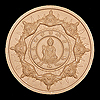|
Jatukam-Ramathep (จตุคาม-รามเทพ)
Thai.
Name of a large, very popular
amulet
in the shape of a medallion, about 6 millimeters thick and
a diameter of around 5.4 centimeters. The original
Jatukam-Ramathep amulets were introduced in the 1980's by Khun Phantharak
Rajadej, a police chief from
Nakhon Sri Thammarat,
to raise funds for the construction of a
lak meuang
(city pillar). The amulet was then priced
at 49 baht. The amulets became very popular when the Police Major General died
at the age of 103 (some say 108) on 5 September 2006, just days before the coup
d'état that ousted prime minister Thaksin Shinawat, and now,
many are sold for more than 100,000 baht each. Believers wear the amulet around the neck as a
talisman
as it is
believed to have magical powers and protect its
owners.
The
front side of the
amulet shows the god
Tao Ramathep (fig.)
seated with the right knee uplifted in a casual yoga position and
surrounded by the animals of the
Chinese
zodiac, a reference to the coat of arms
of Nakhon Sri
Thammarat (fig.),
and by eight figures of the demon-god
Rahu. The
back side shows a relief with some
ancient
yan signs
that have an
animist
protective purpose.
Tao
Ramathep is, together with Tao Kadtukam (Kattukam -
ท้าวขัตตุคาม), the
guardian god of the holy relics of the Buddha. Their statues are carved onto the
doors of
Wat Mahathat Wora Maha Wihaan
in
Nakhon Sri
Thammarat.
The name of Tao Kadtukam was over time understood to be Jatukam,
hence its present designation. However, since jatu (จตุ) is a word that derives
from Pali and means ‘four’, as in
jatulohkabahn,
i.e. the ‘four guardians of the world’, it is also said that
the name Jatukam-Ramathep in fact refers to four deities
found within the wihaan of
Wat Mahathat Wora Maha
Wihaan, who
besides Tao Kadtukam and
Tao
Ramathep, whose depictions are in bas-relief on the
doors, are Tao Wirunhok (ท้าววิรุฬหก) and Tao Wirunpak (ท้าววิรุฬปักษ์),
represented in the two gold statues located on the left and
right top of the staircase, respectively. Together, the four
are known as Tao Jatu
Maha Raj
(ท้าวจาตุมหาราช). Buddhists today have become obsessed with this alleged
magic amulet, despite warnings that the circular icon is only a secular crutch, corrupting both religion and society. Due to its magical
claims and a highly inflated resale value the amulet has caused an out-of-control
craze.
Thieves have broken into shops
and homes
and infiltrated temples to steal it. Then, the
Supreme Patriarch of
Thailand
allowed materials from his temple, such as ash from incense and powder from
bricks, to be made into the controversial amulets and when in April 2007 a fresh batch of
the lucrative charm went on sale in southern Thailand, a crowd of thousands waiting to
buy coupons they could exchange for the amulets erupted into a
stampede, trampling a woman to death and injuring
many others. A few weeks later, the Supreme Patriarch stopped providing
materials for the amulets. The
first generation of amulets issued in 1987 AD, is also referred to as Phra Phong
Suriyan-Jantrah (พระผงสุริยัน-จันทรา). See also
Tao Ramathep and
POSTAGE STAMPS.
回






|

